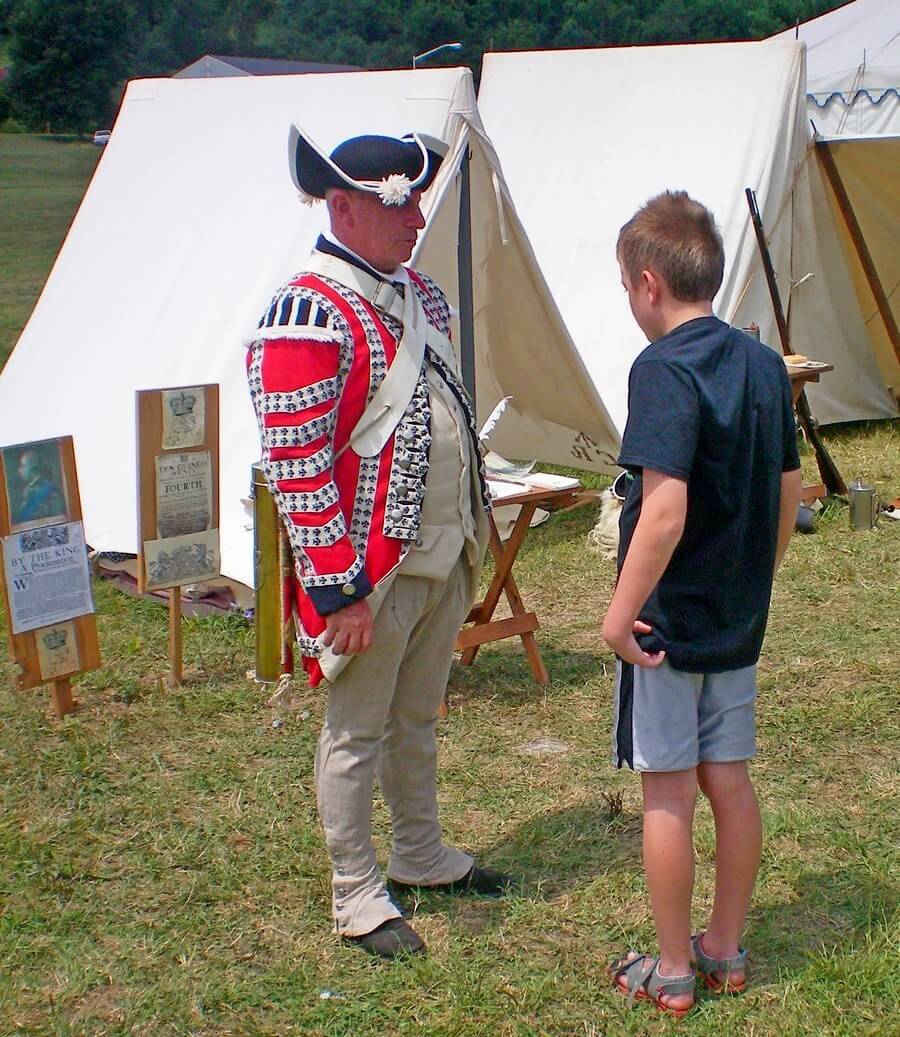Jim Glanville

Owen Munsell (right) listens to reenactor Jeff Briggs at a recent festival in Elliston celebrating the Great Wagon Road, which went from Philadelphia to Bristol. Briggs is playing the role of fifer in a British Guards company.
In the late eighteenth century the Great Wagon Road went from Philadelphia to today’s Bristol at the Tennessee-Virginia border. Interstate I-81 follows roughly the same path south of Harrisburg, Pennsylvania.
A recent weekend encampment in Elliston celebrated the heyday of the Great Road with events such as glassblowing, blacksmithing, camp cooking, flint lock musket handling, tomahawk throwing and demonstrations of period clothing and period spinning and weaving.
I went with my neighbor John Munsell and his son Owen. In the accompanying picture, Owen can be seen listening to the reenactor Jeff Briggs, who is playing the role of a fifer in a British Guards company.
In 1952, the historian Carl Bridenbaugh wrote: “In the last sixteen years of the colonial era, southbound traffic along the Great Philadelphia Wagon Road was numbered in tens of thousands; it was the most heavily traveled road in all America and must have had more vehicles jolting along its rough and tortuous way than all other main roads put together.”
At the end of the French and Indian War in 1763, Anglo-American colonists began to pour westward to find land to settle, regardless of the fact that they had no legal claim to it.
The American Indians had historically occupied the land, and private companies claimed much of the land. The Virginia elite encouraged this movement, because they had invested heavily in these land companies to diversify their holdings. To some extent, the sale of land replaced the sale of tobacco.
British military officials attempted to halt the flow, but the eager settlers and land speculators ignored them. With the military unwilling to forcibly remove the intruders, people continued to migrate west and settle.
The Guards have been an elite British fighting unit for 375-years. They began in 1642 when Charles I formed the Scots Guards. Oliver Cromwell formed the Coldstream Guards (Coldstream is a town on the Tweed river at the Scottish-English border) in 1650, Charles II formed the Foot Guards by while in exile in France. In 1678, grenadier companies were created as part of the Guards.
Grenadiers were armed with a bag of grenades, a hatchet, a musket and bayonet, and tasked to lead assaults on fortifications by hacking away obstacles with their hatchet. Grenadiers had to be tall and strong.
The Guards did not see action in the French and Indian War in America (1755-1763). During that period they were mostly used in the West Indies. Conversely, a special detachment of guards was in America during most of the Revolution.
Jeff Briggs reenacts as a Revolutionary War fifer — a musician private in a company of the First Regiment of Foot Guards. He is a student of the uniforms of the musicians of both the American and British armies of that time. Mainly fifers and drummers provided music in these armies.
Being a fifer brought significant responsibilities. A fifer would have to learn popular tunes to entertain the soldiers. Furthermore, an eighteenth century army musician would transmit orders in battle and regulate the daily routine of the soldiers in camp.
In battle, fifers wore ornately decorated uniforms of a much higher quality than the uniform of the standard soldier. The uniforms allowed commanders to readily see their fifers, even over the smoke and haze of battle, and transmit orders to them for playing. During a battle, a military band concentrated on playing, and was usually armed only with swords for any needed self-defense.
In camp, the music of reveille and tattoo awoke soldiers and sent them to bed. Other camp music announced mealtimes, and calls for duties such as wood gathering and getting water.
On the march, accompanying music provided a cadence to regulate the rate of speed. Music played on the march, or in camp, could help bolster the hearers’ morale.
During the Revolutionary War, a composite Guards brigade composed of two battalions of five companies each (about 1,000 total men) arrived in Sandy Hook, New York in 1776. The brigade went into the field in May of 1777, and was in combat that year at Brandywine, Valley Forge, Germantown and White Marsh before it went into winter quarters in Philadelphia.
Later, the Guards went south and saw action in March 1781 at the battle of Guilford Courthouse (near Greensboro, NC) where they suffered heavy casualties and their brigade was reduced to one battalion of 4 under-strength companies.
In October 1781, many Guards (the Yorktown National Park website says 398 men were present and fit for duty) were part of the British force that surrendered at Yorktown. The officers were paroled, but the men were marched into captivity at York, Pennsylvania, where they remained until 1783.
Thus it was that a neighborly visit to a Montgomery County reenactment event provided an excuse for this columnist to review a lot of interesting history.
Jim Glanville is a retired chemist living in Blacksburg. He has been publishing and lecturing for more than a decade about the history of Southwest Virginia.

